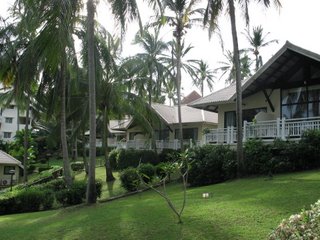His task was to set up the first European settlement in Australia known then as New South Wales. Despite being a penal colony, to obviate the problem of overcrowded British gaols due to the recent loss of their American colonies, this was first and foremost a strategic and commercial decision by Great Britain to prevent the French, Dutch or Spanish dominating the region.
Botany Bay had been suggested as a suitable site some 18 years before by the naturalist Sir Joseph Banks who had accompanied Captain James Cook on his exploration of the east coast of the great south land.
This was however not the case. Lack of a good anchorage and fresh water plus poor soil encouraged Phillip to look a few miles further north where Cook had noted an opening in the coast line writing in his journal "at noon we where...about 2 or 3 miles from the land and abrest of a bay or harbour within there appeared to be a safe anchorage which I called Port Jackson."
After a successful reconnoiter by Phillip a few days before, on 26th January, the fleet entered Port Jackson (Sydney Harbour) and landed on a spot which he called Sydney Cove where possession of New South Wales was formally declared and the British flag raised.
This was the first Australia Day.
Of course the area was already occupied by the Cadigal aboriginal clan of the Eora people and despite initial orders to treat the native inhabitants well, their and the rest of the continent's indigenous population's troubles had just begun. But that is another story.
 | |
| Sydney Cove: Then and Now |
At school this was about the only information we learnt about Arthur Phillip; that and his governorship of the colony under very difficult conditions for the next 4 years.
I came across a book detailing not only Arthur's governorship but also his earlier days and post New South Wales life.
And what an interesting diverse life he led.
Born into a family of modest means, the death of his father caused hardship. At the age of 13 he was accepted into the Greenwich Hospital School, a charity school for the sons of poor seafarers. Here his education concentrated on literacy, arithmetic and navigational skills including cartography. After serving on whaling and cargo ships, he joined the British navy and saw active service during the Seven Years War.
He then married an older lady of considerable means and became a gentleman farmer. But this union only lasted six years and he returned to the navy.
He then joined the Portuguese navy and saw action against the Spanish as a ship's captain in South American waters.
Then it was back to the British navy for a six year stint after which, for two years, he was recruited to spy on the French naval arsenals at Toulon and other ports.
His colonial service began in late 1786 with preparation for the voyage to Australia.
He returned to the UK from Australia in 1793 in ill health but on recovery remarried. In 1796 he went back to sea, holding a series of commands and responsible shore posts in the wars against the French, finally retiring with the rank of Admiral of the Blue.
He died in Bath, UK, in 1814.
As Pembroke writes 'History and circumstance combined to make Phillip an astute choice (to establish the first Australian settlement). He knew the South Atlantic and was familiar with the Canaries, Rio de Janeiro and Cape Town. He had doubled the Cape of Good Hope and crossed the Indian Ocean to the Bay of Bengal. He had served as a covert agent in France and understood its naval threat and probably also its territorial aspirations. He had experience as a farmer at Lyndhurst. He was cerebral and his natural disposition was thoughtful. He had impressed the Portuguese Viceroy in Brazil and gained the confidence of the British administration in Whitehall. And if there is any substance in the legend about him, he had already transported a shipload of convicts from Lisbon to Brazil.'





















No comments:
Post a Comment